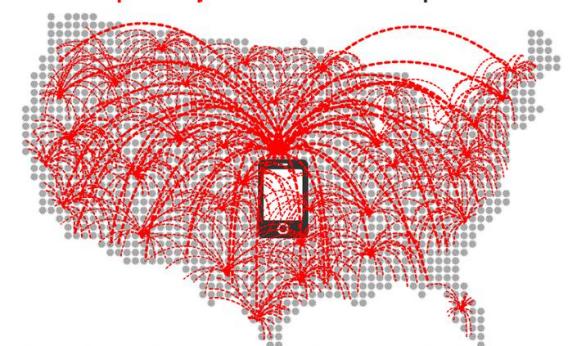The One GIF That Shows Just How Wide the NSA's Surveillance Net Really Is
If you’re like most people, you were mildly outraged, if not entirely shocked, by the recent series of revelations about the nature and extent of the NSA’s surveillance programs. You realized vaguely that they cast a wider net than many had assumed, potentially taking in the phone and Internet records of many innocent American citizens along with terrorism suspects overseas. But perhaps it was never quite clear just how likely it was that you in particular—yes, innocent little you—might have your phone records scooped up in the hunt for potential terror suspects. The infographic below, released Wednesday by the ACLU, provides perhaps the simplest visualization yet of just how broad the NSA’s “three hops” standard for collecting data really is.

The phrase “three hops,” which comes from NSA honcho John Inglis’ testimony to the House Judiciary Committee in July, means that the agency can look at the communications of the person it’s targeting, plus the communications of that person’s contacts (one hop), plus the communications of those people’s contacts (two hops), plus the communications of those people’s contacts (three hops). Each hop widens the net exponentially, so that if the average person has 40 contacts, a single terrorism suspect could theoretically lead to records being collected on 2.5 million people. Take into account that the NSA may have thousands, tens of thousands, or even upwards of 117,000 “active surveillance targets,” and the map turns red in a big hurry. Like, almost entirely red.
How many of those records the NSA actually looks at in any given investigation is unclear. Inglis said in his testimony that it would be a waste of time for NSA agents to dive into the data on more people than necessary, and that agents "try to be judicious about when to do a second hop." He added, according to the Washington Post:
If on that second hop you see that that’s hopped to a foreign number already known to the intelligence community, because it’s a known terrorist, you’d want to make the third hop to understand what’s beyond that.
So if you want to be reassured, focus on the fact that the NSA probably looks at only a small portion of the records it collects. If you want to be spooked, focus on the odds that your phone records will, at some point, in the course of some investigation, be among those the NSA sweeps up—and that the NSA's own self-proclaimed "judiciousness" is the only thing standing in the way.
Future Tense is a partnership of Slate, New America, and Arizona State University.

